Introduction
Florida is home to one of North America's most unique and diverse ecosystems, the seepage slope. Unusual hydrology and frequent fires combine to create an environment that supports a variety of carnivorous and other sun-loving herbaceous plants (Figure 1). William Bartram was an early American naturalist who explored the southern American colonies. He wrote of the natural beauty of these areas in 1791, saying, "Observe these green meadows how they are decorated; they seem enameled with the beds of flowers." Bartram was rightfully impressed because more species of carnivorous plants flourish in seepage slopes that occur in the Southeastern Coastal Plain than anywhere else in the country (Hermann, 1995). Since the arrival of the first Europeans, the extent of seepage slopes has declined greatly because of changes people made to the flow of water through the environment and because people suppressed fire, which allowed trees and shrubs to take over habitat and shade out the unique plants (FNAI 2010). This article discusses the natural history and conservation concerns associated with seepage slope wetlands.
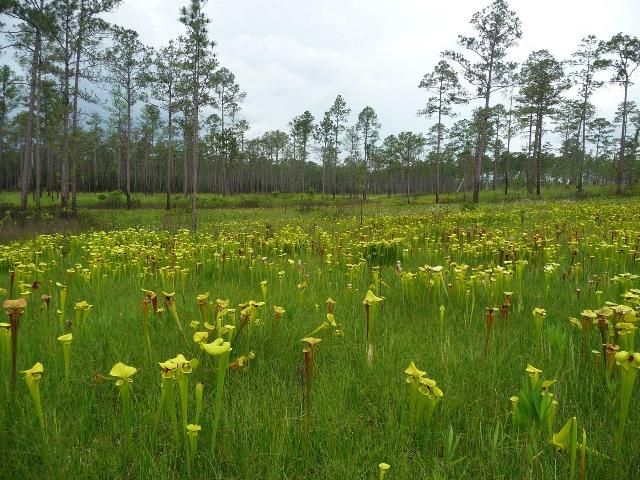
Credit: M. Brown, UF/IFAS
Synonyms
Seepage slopes and similar communities may also be referred to as pitcherplant bogs, hanging bogs (Folkerts 1982), seepage bogs (Clewell 1986), or herb bogs (FNAI 1990).
Distribution
Seepage slope wetlands can be found along the Lower Gulf Coastal Plain physiographic region of Florida and Alabama. In the Florida Panhandle, these systems range from the Alabama border to Calhoun County (FNAI 2010) and may be located up to 100 km inland (Folkerts 1982). They are also found in portions of the northern Florida peninsula (Johnson 2001). Some of the largest remaining expanses of seepage slopes occur on Eglin Air Force Base in the western Panhandle (FNAI 2010). Similar communities that differ in both the plant assemblages and soil type can be found along the Atlantic Coastal Plain and from Florida to eastern Texas (Folkerts 1982).
Physical Environment
As the name implies, seepage slopes are wetlands located on the sides of rolling hills (Folkerts 1982). This topographic location is where the upland pine community slopes down to a dendritic system of streams (resembling the branches of a tree). These herbaceous communities slope 30 to 50 feet down to shrub-dominated streams often referred to as shrub bogs or baygalls because of the prevalence of species such as sweetbay (Magnolia virginiana) (Figure 2) (FNAI 2010). The loamy sand soils are generally saturated with water, resulting in anaerobic conditions. Plants have evolved the ability to trap insects in order to acquire nutrients in these anaerobic and acidic conditions that limit nutrient availability. Soil saturation is sustained by the downslope seepage of groundwater above an impermeable layer of clay, organic matter, or rock. The impermeable layer prohibits groundwater penetration and results in seeps along the hillsides. These wetlands may dry out in times of drought because they depend on groundwater. Water that seeps from the hillside slopes flows into seepage creeks.
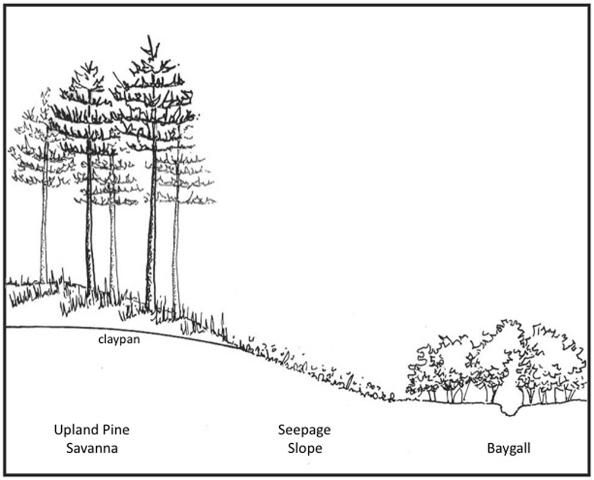
Credit: L. Brown, UF/IFAS
Biological Components
Seepage slope communities are open prairies dominated by grasses and sedges. Upslope from these wet prairies are pine communities with an open overstory of slash pine (Pinus elliottii) or longleaf pine (Pinus palustris). Within these wet prairies, shrubs are maintained at a reduced height by frequent fire and commonly include titi (Cyrilla racemiflora), large gallberry (Ilex coriacea), inkberry (Ilex glabra), woolly huckleberry (Gaylussacia mosieri) and sweetbay magnolia (Magnolia virginiana).The characteristic dense and diverse herbaceous prairie vegetation includes beaksedge (Rhychospora spp.), wiregrass (Aristida beyrichiana), toothache grass (Ctenium aromaticum), panicgrass (Dicanthelium spp.), cutover muhly (Muhlenbergia expansa), pitcherplants (Sarracenia spp.), yellow-eyed grasses (Xyris spp.), meadowbeauty (Rhexia alifanus), pipeworts (Eriocaulon spp.), sundews (Drosera spp.), butterworts (Pinguicula spp.), clubmoss (Lycopodiella spp.), and orchids (Orchidaceae) (FNAI 2010).
There are many rare or endemic species (species that occur nowhere else) that can be found in seepage slopes in the Florida Panhandle. The most notable are the carnivorous plants of the pitcherplant family, Sarraceniacea (Figure 3). Members of this family include the yellow trumpet (Sarracenia flava), white-top pitcherplant (S. leucophylla) (endangered in Florida), hooded pitcherplant (S. minor) (threatened in Florida), sweet pitcherplant (S. rubra) (threatened in Florida), purple pitcherplant (Sarracenia purpurea) (threatened in Florida), and parrot pitcherplant (S. psittacina) (threatened in Florida). Other carnivorous flora, including the dewthread (Drosera tracyi), threadleaf sundew (D. filiformis) (endangered in Florida), pink sundew (D. capillaris), dwarf sundew (D. brevifolia), bladderworts (Utricularia spp.), and butterworts (Pinguicula spp.), also inhabit seepages slopes (FNAI 2010).

Credit: M. Brown, UF/IFAS
These communities are additionally home to the following rare plants: naked-stemmed panic-grass (Dichanthelium nudicaule) (threatened in Florida), dark-headed hatpin (Eriocaulon nigrobracteatum) (endemic to Florida and threatened in the state), pineland bogbutton (Lachnocaulon digynum) (threatened in Florida), panhandle lily (Lilium iridollae) (endangered in Florida) (Figure 4), hummingbird flower (Macranthera flammea) (endangered in Florida), primrose-flowered butterwort (Pinguicula primuliflora) (endangered in Florida), giant water-dropwort (Oxypolis greenmanii) (endemic to Florida and endangered in the state), yellow fringeless orchid (Platanthera integra) (endangered in Florida), and Harper's yellow-eyed grass (Xyris scabrifolia) (threatened in Florida) (FNAI 2010).
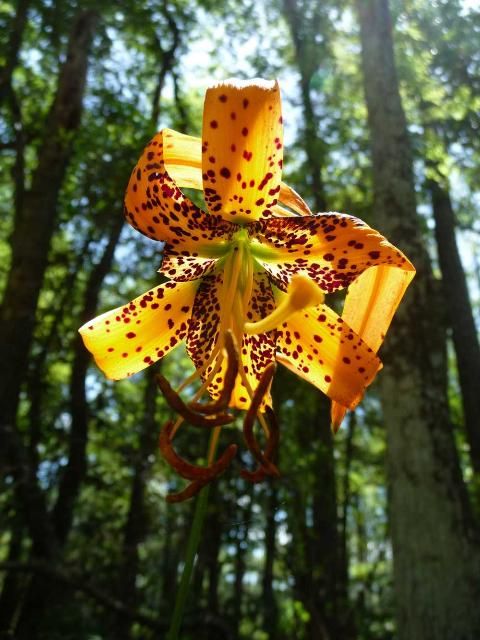
Credit: M. Brown, UF/IFAS
Seepage slopes are also important to several species of reptiles, amphibians, birds, and mammals. These animals include both common species, like cottonmouth snakes (Agkistrodon piscivorus), and very rare species, like mimic glass lizards (Ophisaurus mimicus). Pine barrens treefrogs (Hyla andersonii) were once listed as federally endangered but have been delisted and are considered rare in Florida. These treefrogs only inhabit seepage slopes in the western Panhandle (Santa Rosa, Okaloosa, and Walton Counties).The Florida bog frog (Lithobates okaloosae) is an endemic species, found only in seepages slopes in Okaloosa and Santa Rosa Counties. One-toed amphiumas (Amphiuma pholeter) are rare in Florida and only found in about 40 localities. Southern dusky salamanders (Desmognathus auriculatus) are a species of special concern because they have been lost from more than 50 historic sites in Florida. Seal salamanders (Desmognathus monticola) and bog dwarf salamanders (Eurycea cf. quadridigitata) are known to inhabit seepage slopes. Chamberlain's dwarf salamanders (Eurycea chamberlaini) can also be found in seepage slopes, but little is know about this species. Four-toed salamanders (Hemidactylium scutatum) are rare in Florida. The gray rat snake (Pantherophis spiloides) and eastern ribbon snake (Thamnophis sauritus sauritus) are both common, non-venomous snakes that can be found in seepage slopes. Other reptiles include the venomous southern copperhead snake (Agkistrodon contortrix contortrix) and southern coal skink (Eumeces anthracinus pluvialis). The Louisiana waterthrush (Parkesia motacilla), which nests along creeks and wetlands, is the rarest and least studied of the birds that breed in Florida. More common birds that prefer to nest in shrubs near open areas include the yellow-breasted chat (Icteria virens), eastern towhee (Pipilo erythrophthalmus), common yellowthroat (Geothlypis trichas), and blue grosbeak (Guiraca caerulea). White-tailed deer (Odocoileus virginianus), Florida black bear (Ursus americanus floridanus) (endangered in Florida), coyote (Canis latrans), and several species of bat, including the northern yellow bat (Lasiurus intermedius floridanus), also use these wetlands (FWC 2005).
Threats and Management Concerns
Historically, serious pressures have resulted in the loss of seepage slope communities. Many of these areas have been converted into private ponds or drained for pine plantations and other development. Roads, ditches, right-of-ways and fire plow lines have permanently disrupted the hydrology of many seepage slopes. Herbicide application and the over-collection of rare plants have also harmed these communities (Folkerts 1982). Currently, only 1% of seepage slopes that originally existed along the Gulf Coastal Plain are still intact (FNAI 1990). Exotic feral hogs (Sus scrofa) and fire suppression threaten the remaining seepage slopes (FNAI 2010).
Impacts of Fire Regime Alteration
Woody species invade seepage slopes, outcompeting herbaceous species in the absence of fire or with alteration of the natural fire regime (Johnson 2001) (Figure 5). Frequent low-intensity fire is the most important process maintaining the open canopy and herbaceous composition of these communities. Historically, fires burned through the surrounding uplands about every one to three years (Frost 2006). It is thought that lightening ignited these fires during the spring or the beginning of the growing season (Olson 1992). These lightening-producing thunderstorms coincided with spring drought so that upland fires spread down into dry seepage slopes (Olson and Platt 1995). Encroachment of woody species as a result of fire suppression shades out the sun-loving herbaceous species.
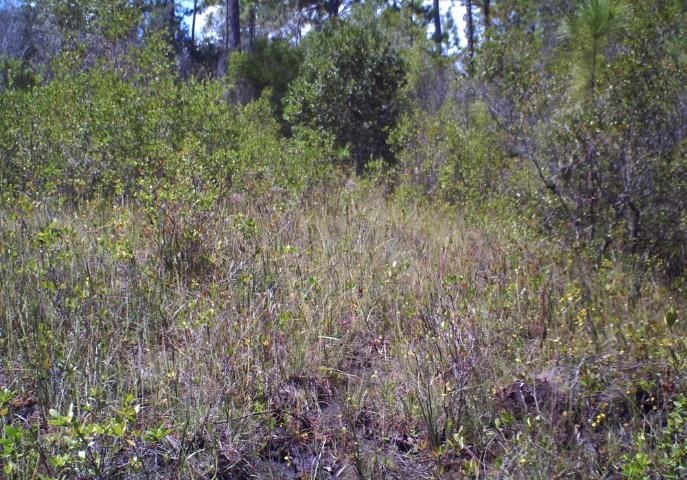
Credit: M. Brown, UF/IFAS
Feral Hog Impacts
The savannas and associated ecosystems of the southeastern United States did not evolve with foraging pressure from wild hogs. De Soto introduced domestic hogs during his travels through Florida and eight other states (Mayer and Brisbin 1991). Feral hogs are now one of the most serious threats to seepage slope communities on Eglin Air Force Base. These nonindigenous animals are generalists whose diet consists primarily of fruits, nuts, grasses, forbs, roots, and earthworms. Hogs forage underground by rooting or using their snouts to overturn soil. This belowground foraging uproots vegetation (Engeman et al. 2007), creates hummocks and tussocks that disrupt soil structure (Jensen 1985) and moisture (Arrington et al. 1999), increases areas of bare ground (Engeman et al. 2007), and facilitates soil erosion (Tep and Gaines 2003) (Figure 6). Disturbance from hogs is not uniform across the seepage slope. Our unpublished research has found that hogs preferentially disturb areas in the lower, wetter portions of the seepage slopes, especially areas that have been previously disturbed. This suggests that the erosion, plant mortality, and excrement deposition associated with hog disturbance is not uniform across the landscape. This has implications for the persistence of rare plants (pitcherplants) and amphibians that inhabit the wetter portions of the slope.
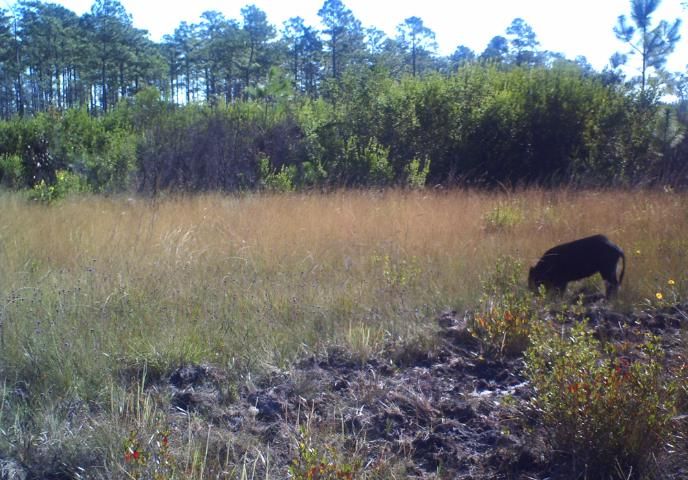
Credit: M. Brown, UF/IFAS
Damage to native plants from extensive, repetitive rooting by feral hogs is possible in sensitive communities like seepage slopes (Engeman et al. 2007). Rooting by hogs can dramatically reduce plant diversity (the number of plant species) resulting in the dominance of only fast-growing, early successional species. In addition to a loss of rare and sensitive species, dominant flora, such as wiregrass (Aristida beyrichiana), are also negatively affected. Wiregrass is a shallow-rooted grass and is an important component of the system. Yet recurring rooting by hogs reduces wiregrass cover even to the point where it may be lost completely. Sarracenia species are sensitive to hog disturbance too (Johnson 2001). Trampling and rooting, both the physical action and associated changes in soil moisture, negatively impact survival of juvenile Sarracenia (Hermann 1995). So it is not surprising that a recent study showed that abundance of white-top pitcherplants and yellow trumpets are both negatively correlated with areas of hog disturbance (Engeman et al. 2007). Research at the University of Florida is closely examining the effects of hog rooting on seepage slope vegetation and the potential for natural recovery in the absence of hogs.
The Future
These communities are experiencing a state-wide decline that threatens extirpation (local extinction) of rare species (Johnson 2001). Seepage slopes are, for the most part, poorly understood despite their intrinsic beauty and scientific value. There is a need for more quantitative studies and a broader dissemination of information. Ultimately, the education and interest of the general public may be crucial to protect this diverse ecosystem. Public education may be made possible with natural visitation areas or the construction of artificial pitcherplant habitats at parks. Along with education, land mangers must be persistent with prescribed burns and feral hog control (Hermann 1995). Management must also include monitoring programs so that actions can be taken to avoid extirpation of rare species before it is too late (Johnson 2001). It would be biologically devastating to lose the remaining seepage slope wetlands because they are such an important part of this state's ecological heritage.
References and Additional Information
Arrington, D. A., L. A. Toth, and J. W.Koebel.1999. "Effects of rooting by feral hogs Sus scrofa L. on the structure of a floodplain vegetation assemblage." Wetlands 19(3): 535–544,
Clewell, A. F. 1986. "Natural setting and vegetation of the Florida Panhandle: An account of the environments and plant communities of northern Florida west of the Suwannee River." Report No. COESAM/PDEI-86/001. Mobile District, AL: United States Army Corps of Engineers.
Engeman, R. M., A. Stevens, J. Allen, J. Dunlap, M. Daniel, D. Teague, and B. Constantin. 2007. "Feral swine management for conservation of an imperiled wetland habitat: Florida's vanishing seepage slopes." Biological Conservation 134(3): 440–446.
Florida Fish and Wildlife Conservation Commission (FWC). 2005. Florida's Wildlife Legacy Initiative. Tallahassee, FL: Florida's Comprehensive Wildlife Conservation Strategy.
Florida Natural Areas Inventory (FNAI). 1990. Guide to the natural communities of Florida. Tallahassee, FL: Florida Natural Areas Inventory and Florida Department of Natural Resources.
Florida Natural Areas Inventory (FNAI). 2010. Guide to the natural communities of Florida: 2010 edition. Tallahassee, FL: Florida Natural Areas Inventory and Florida Department of Natural Resources.
Folkerts, G. W. 1982. "The Gulf-Coast Pitcher Plant Bogs." American Scientist 70(3): 260–267.
Frost, C. 2006. History and Future of the Longleaf Pine Ecosystem. Pp 9–42 In Shibu J, Jokela EJ, Miller DL, Eds. Springer, NY: The Longleaf Pine Ecosystem: Ecology, Silviculture, and Restoration.
Hermann, S. M. 1995. Status and management of Florida's carnivorous plant communities. Nongame Wildlife Program project no. GFC-84-033. Tallahassee, FL: Florida Fish and Wildlife Conservation Commission.
Jensen, A. 1985. "The effect of cattle and sheep grazing on salt-marsh vegetation at Skallingen, Denmark." Vegetatio 60: 37–48.
Johnson, E. D. 2001. Pitcherplants and their habitats in the Florida State Park system: resource conditions, trends, and management needs. Resource Management Evaluation. Division of Recreation and Parks, Florida Department of Environmental Protection, Tallahassee.
Mayer, J. J., and I. L. Brisbin. 1991. Wild pigs in the United States: Their life history, morphology and current status. Athens, GA: University of Georgia Press.
Olson, M. S. 1992. Effects of early and late growing season fires on resprouting of shrubs in upland longleaf pine savannas and embedded seepage savannas. Masters Thesis. Louisiana State University.
Olson, M.S., and W. J. Platt. 1995. "Effects of habitat and growing season fires on resprouting of shrubs in longleaf pine savannas." Vegetatio 119: 101–118.
Tep, P., and K. Gaines. 2003. "Reversing the impacts of feral pig on the Hawaiian tropical rainforest ecosystem." Restoration and Reclamation Review 8(3).
https://www.fnai.org/species-communities/natcom-guide
http://www.flmnh.ufl.edu/nwfla/bog.htm
http://www.alachuacounty.us/Depts/EPD/NaturalResources/whatare/Pages/Living_Wetland.aspx
http://www.nwflec.com/northwestfloridaenvironmentalconservancypart2/id11.html